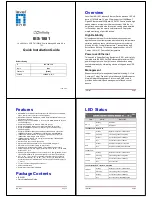
Operating Instructions
Transponder-Coded Safety Switch CTM-CBI-BP
14
(Translation of the original operating instructions) 2541786-01-10/20
9. Electrical connection
The following connection options are available:
Ì
Connection to a control system
Ì
Connection to safety relay ESM-CB with integrated BR/IO-Link Gateway
Ì
Connection to a BR/IO-Link Gateway GWY-CB-1-BR-IO.
WARNING
In the event of a fault, loss of the safety function due to incorrect connection.
Ì
To ensure safety, both safety outputs must always be evaluated.
Ì
Monitoring outputs must not be used as safety outputs.
Ì
Lay the connecting cables with protection to prevent the risk of short circuits.
CAUTION
Risk of damage to equipment or malfunctions as a result of incorrect connection.
Ì
Do not use a control system with pulsing or switch off the pulsing function in your control system.
The device generates its own test pulses on the safety outputs. A downstream control system
must tolerate these test pulses, which may have a length of up to 300 µs.
The test pulses are output only with the safety outputs switched off during device start.
Depending on the inertia of the downstream device (control system, relay, etc.), this can lead to
short switching processes.
Ì
The inputs on a connected evaluation unit must be positive switching, as the two outputs on the
safety switch deliver a level of +24 V in the switched-on state.
Ì
All the electrical connections must either be isolated from the mains supply by a safety transformer
according to IEC 61558-2-6 with limited output voltage in the event of a fault, or by other equivalent
isolation measures (PELV).
Ì
All electrical outputs must have an adequate protective circuit for inductive loads. The outputs
must be protected with a free-wheeling diode for this purpose. RC interference suppression units
must not be used.
Ì
Power devices which are a powerful source of interference must be installed in a separate location
away from the input and output circuits for signal processing. The cable routing for safety circuits
should be as far away as possible from the cables of the power circuits.
Ì
To avoid EMC interference, the physical environmental and operating conditions at the in-
stallation site of the device must comply with the requirements according to the standard
EN 60204-1:2006, section 4.4.2 (EMC).
Ì
Pay attention to any interference fields from devices such as frequency converters or induction
heating systems. Observe the EMC instructions in the manuals from the respective manufacturer.
Important!
If the device does not appear to function when the operating voltage is applied (e.g. green STATE LED
does not flash), the safety switch must be returned to the manufacturer.















































